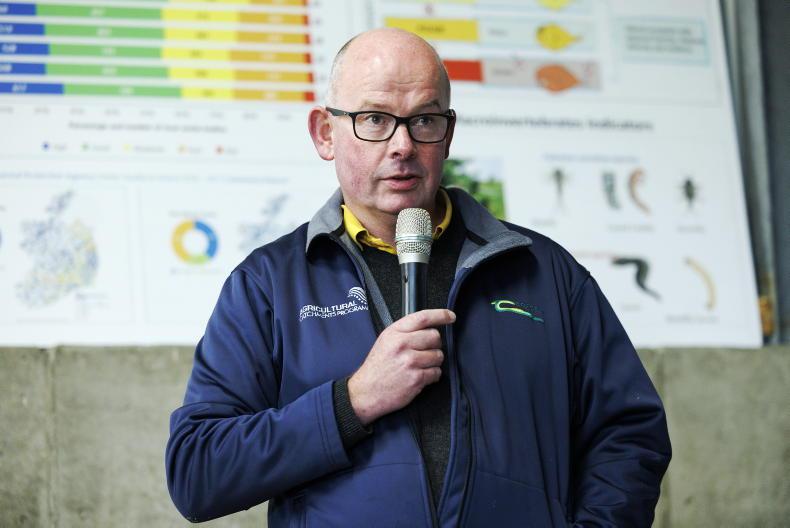Teagasc’s agricultural catchments specialist Eddie Burgess has warned that the latest EPA water quality indicator report does not bode well for retaining the nitrates derogation.
“This report does not show the improvement that will be sought by the European Commission to support a strong case to retain the derogation,” he told the Irish Farmers Journal on Wednesday.
The process of Ireland applying for a derogation begins in December 2024, with a decision not expected until December 2025 or even into early 2026.
Burgess added that there were “no surprises” in the EPA report, published on Wednesday, given that it is based on a three-year average.
“Practices at farm level have not radically changed in the last year. The biggest difference last year was the intensity of the weather, including a drought in June and non-stop rain after that. That weather was very likely to increase nutrient loss to water.”
‘Impossible bar’
The EPA report notes that river nitrate concentration values lower than 4mg/l of nitrate and lower than 8mg/l of nitrate “are needed to maintain high- and good-quality surface waters, respectively”, even though the same report notes there is “currently no environmental quality standards for nitrate in rivers”. The nitrate standard for drinking water is 50mg/l.
The catchment specialist pointed out that the 4mg/l and 8mg/l standards have no regulatory basis, and previous EPA reports said these standards were simply “considered by the EPA” to be indicative of high and good quality.
“Those figures are significantly lower than the 11.5 estuarine value and seem to be becoming more and more entrenched,” he said. “Rivers in an agricultural setting with free-draining soil will find it very difficult to reach those standards. Even a river on an organic farm on free-draining soil will not easily achieve that level of nitrate,” he said.
Describing the levels as an impossible bar to reach in some settings, he said it appeared that even where progress is being made reducing nitrates levels, farmers are being told it is not good enough.
Even where progress is being made reducing nitrates levels, farmers are being told it is not good enough
“If my doctor told me to reduce my cholesterol level from seven to five and I reduced it to 5.5, I would not have got to five, but it would still be a huge achievement.
“Where improvements are made, they should be acknowledged rather than highlighting that they are not good enough.”
The EPA attributes human activities, such as agriculture, waste water (domestic and urban) and forestry, as the primary cause of nutrient loss to waters, but Burgess pointed out that mineralisation in free-draining soils is another major factor in water nutrient levels, and is not related to stocking or fertiliser application rate (farming intensity).
He also pointed out that chemical fertiliser application has dropped significantly in the last two years (down 32% in the past two years), but yet water nitrate concentrations had not dropped in tandem.
Nonetheless, he warned farmers not to underestimate the significance of all farming activities on water quality in estuaries much further downstream from where they farm.

Eddie Burgess, agricultural catchments programme, Teagasc, speaking at an IFA water quality event in Co Waterford. \ Donal O'Leary
“Nitrate comes from soil, and farming activity in a catchment, including ploughing of grassland, may result in a cumulative effect on the estuary 100 miles away,” he pointed out.
“In many cases where your local river quality is good, your land can still be a source of nitrate that passes through your soil into groundwater, and via the river downstream eventually affecting the estuary.”
Read more
No significant change to water quality in 2023 – EPA
Farmers are 100% committed to water quality - ICOS
'Relentless focus' on farms to improve water quality - IFA
Teagasc’s agricultural catchments specialist Eddie Burgess has warned that the latest EPA water quality indicator report does not bode well for retaining the nitrates derogation.
“This report does not show the improvement that will be sought by the European Commission to support a strong case to retain the derogation,” he told the Irish Farmers Journal on Wednesday.
The process of Ireland applying for a derogation begins in December 2024, with a decision not expected until December 2025 or even into early 2026.
Burgess added that there were “no surprises” in the EPA report, published on Wednesday, given that it is based on a three-year average.
“Practices at farm level have not radically changed in the last year. The biggest difference last year was the intensity of the weather, including a drought in June and non-stop rain after that. That weather was very likely to increase nutrient loss to water.”
‘Impossible bar’
The EPA report notes that river nitrate concentration values lower than 4mg/l of nitrate and lower than 8mg/l of nitrate “are needed to maintain high- and good-quality surface waters, respectively”, even though the same report notes there is “currently no environmental quality standards for nitrate in rivers”. The nitrate standard for drinking water is 50mg/l.
The catchment specialist pointed out that the 4mg/l and 8mg/l standards have no regulatory basis, and previous EPA reports said these standards were simply “considered by the EPA” to be indicative of high and good quality.
“Those figures are significantly lower than the 11.5 estuarine value and seem to be becoming more and more entrenched,” he said. “Rivers in an agricultural setting with free-draining soil will find it very difficult to reach those standards. Even a river on an organic farm on free-draining soil will not easily achieve that level of nitrate,” he said.
Describing the levels as an impossible bar to reach in some settings, he said it appeared that even where progress is being made reducing nitrates levels, farmers are being told it is not good enough.
Even where progress is being made reducing nitrates levels, farmers are being told it is not good enough
“If my doctor told me to reduce my cholesterol level from seven to five and I reduced it to 5.5, I would not have got to five, but it would still be a huge achievement.
“Where improvements are made, they should be acknowledged rather than highlighting that they are not good enough.”
The EPA attributes human activities, such as agriculture, waste water (domestic and urban) and forestry, as the primary cause of nutrient loss to waters, but Burgess pointed out that mineralisation in free-draining soils is another major factor in water nutrient levels, and is not related to stocking or fertiliser application rate (farming intensity).
He also pointed out that chemical fertiliser application has dropped significantly in the last two years (down 32% in the past two years), but yet water nitrate concentrations had not dropped in tandem.
Nonetheless, he warned farmers not to underestimate the significance of all farming activities on water quality in estuaries much further downstream from where they farm.

Eddie Burgess, agricultural catchments programme, Teagasc, speaking at an IFA water quality event in Co Waterford. \ Donal O'Leary
“Nitrate comes from soil, and farming activity in a catchment, including ploughing of grassland, may result in a cumulative effect on the estuary 100 miles away,” he pointed out.
“In many cases where your local river quality is good, your land can still be a source of nitrate that passes through your soil into groundwater, and via the river downstream eventually affecting the estuary.”
Read more
No significant change to water quality in 2023 – EPA
Farmers are 100% committed to water quality - ICOS
'Relentless focus' on farms to improve water quality - IFA







 This is a subscriber-only article
This is a subscriber-only article










SHARING OPTIONS: